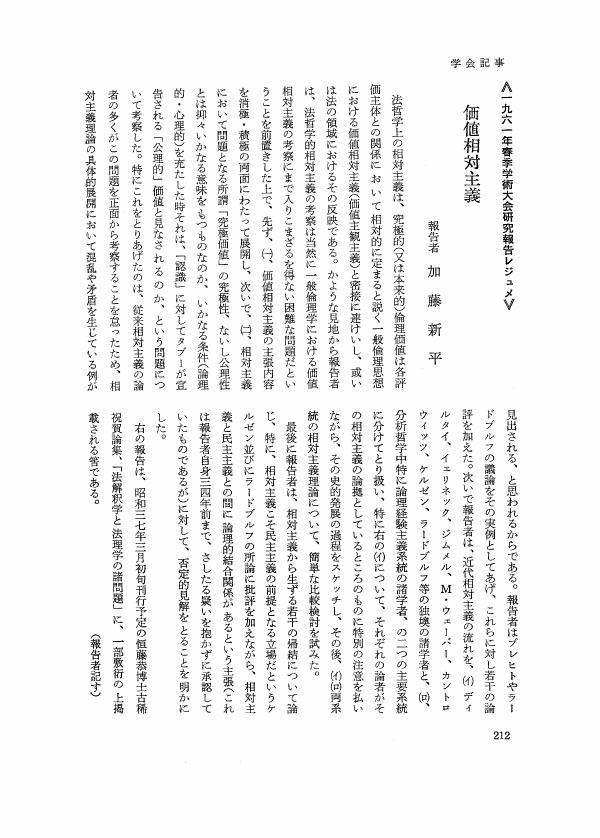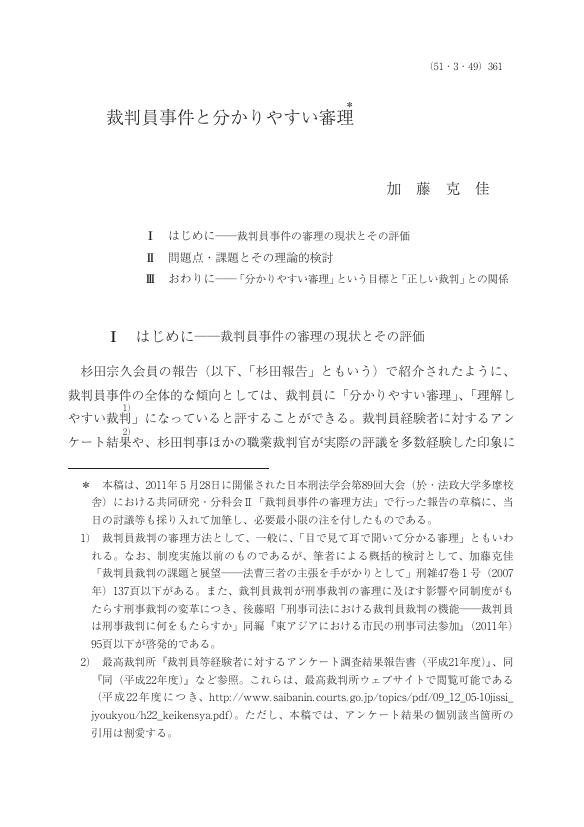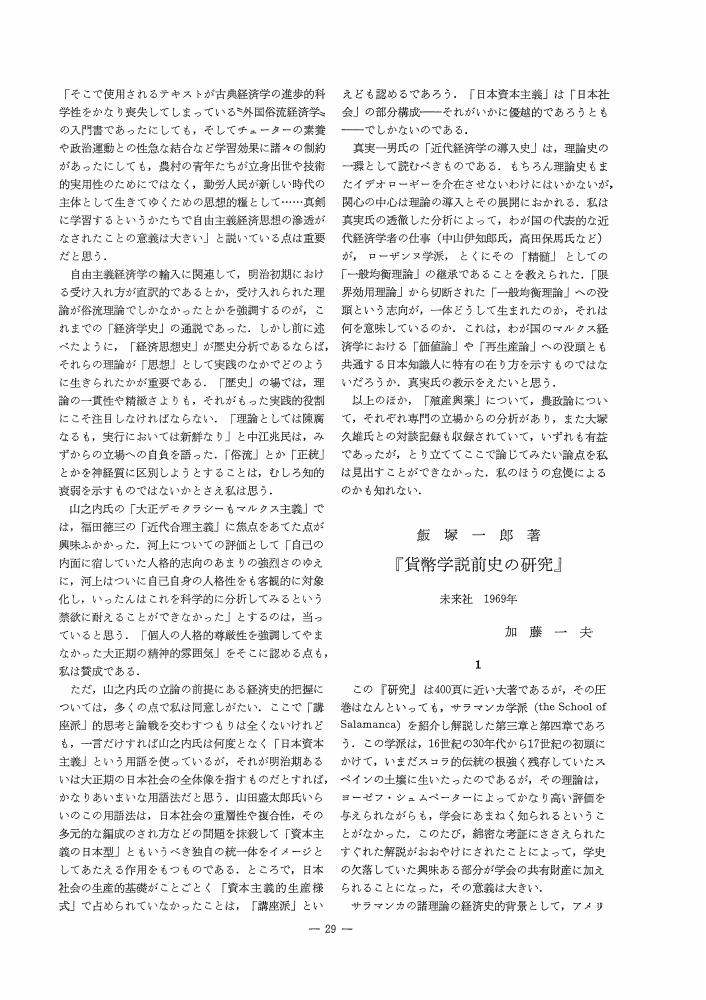1 0 0 0 OA 食材研究(3 ) (ウツボ)の料理
- 著者
- 鳥居 久雄 加藤 彩
- 出版者
- 名古屋文化短期大学
- 雑誌
- 研究紀要 (ISSN:09148353)
- 巻号頁・発行日
- vol.44, pp.19-27, 2019 (Released:2020-03-25)
1 0 0 0 OA 法哲学の学問的性格・基本任務・諸課題 私の法哲学観
- 著者
- 加藤 新平
- 出版者
- 日本法哲学会
- 雑誌
- 法哲学年報 (ISSN:03872890)
- 巻号頁・発行日
- vol.1973, pp.25-70, 1974-10-30 (Released:2009-02-12)
- 参考文献数
- 49
1 0 0 0 OA 法源論についての覚書
- 著者
- 加藤 一郎
- 出版者
- 日本法哲学会
- 雑誌
- 法哲学年報 (ISSN:03872890)
- 巻号頁・発行日
- vol.1964, pp.85-91, 1965-04-20 (Released:2009-02-12)
1 0 0 0 OA 価値相対主義
- 著者
- 加藤 新平
- 出版者
- 日本法哲学会
- 雑誌
- 法哲学年報 (ISSN:03872890)
- 巻号頁・発行日
- vol.1961, pp.212-213, 1962-04-30 (Released:2009-02-12)
1 0 0 0 OA 加藤幸治:サービス経済化時代の地域構造
- 著者
- 加藤 和暢
- 出版者
- 公益社団法人 日本地理学会
- 雑誌
- 地理学評論 Series A (ISSN:18834388)
- 巻号頁・発行日
- vol.84, no.4, pp.382-384, 2011-07-01 (Released:2015-09-28)
1 0 0 0 OA 5 司法取引
- 著者
- 加藤 克佳
- 出版者
- 日本刑法学会
- 雑誌
- 刑法雑誌 (ISSN:00220191)
- 巻号頁・発行日
- vol.55, no.3, pp.532-537, 2016-05-20 (Released:2020-11-05)
1 0 0 0 OA 自白法則について 現状と課題
- 著者
- 加藤 克佳
- 出版者
- 日本刑法学会
- 雑誌
- 刑法雑誌 (ISSN:00220191)
- 巻号頁・発行日
- vol.52, no.1, pp.71-94, 2013-03-10 (Released:2020-11-05)
1 0 0 0 OA 裁判員事件と分かりやすい審理
- 著者
- 加藤 克佳
- 出版者
- 日本刑法学会
- 雑誌
- 刑法雑誌 (ISSN:00220191)
- 巻号頁・発行日
- vol.51, no.3, pp.361-377, 2012-03-30 (Released:2020-11-05)
1 0 0 0 OA 犯罪被害者の権限拡充法制の意義と課題
- 著者
- 加藤 克佳
- 出版者
- 日本刑法学会
- 雑誌
- 刑法雑誌 (ISSN:00220191)
- 巻号頁・発行日
- vol.47, no.3, pp.393-408, 2008-04-10 (Released:2020-11-05)
1 0 0 0 OA 5 裁判員制度
- 著者
- 加藤 克佳
- 出版者
- 日本刑法学会
- 雑誌
- 刑法雑誌 (ISSN:00220191)
- 巻号頁・発行日
- vol.47, no.2, pp.306-310, 2008-02-10 (Released:2020-11-05)
1 0 0 0 OA 裁判員裁判の課題と展望 法曹三者の主張を手がかりとして
- 著者
- 加藤 克佳
- 出版者
- 日本刑法学会
- 雑誌
- 刑法雑誌 (ISSN:00220191)
- 巻号頁・発行日
- vol.47, no.1, pp.137-152, 2007-11-10 (Released:2020-11-05)
1 0 0 0 OA インドネシアにおけるレーダーとラジオゾンデを用いた赤道大気力学の観測 : 速報
- 著者
- 津田 敏隆 深尾 昌一郎 山本 衛 中村 卓司 山中 大学 足立 樹泰 橋口 浩之 藤岡 直人 堤 雅基 加藤 進 Harijono Sri Woro B. Sribimawati Tien Sitorus Baginda P. Yahya Rino B. Karmini Mimin Renggono Findy Parapat Bona L. Djojonegoro Wardiman Mardio Pramono Adikusumah Nurzaman Endi Hariadi Tatang Wiryosumarto Harsono
- 出版者
- 社団法人日本気象学会
- 雑誌
- Journal of the Meteorological Society of Japan. Ser. II (ISSN:00261165)
- 巻号頁・発行日
- vol.73, no.2, pp.393-406, 1995-06-15
- 被引用文献数
- 20
日本とインドネシアの協力により1992年11月にジャカルタ近郊に赤道大気の観測所(6.4°S、106.7゜E)が開設され、流星レーダー(MWR)と境界層レーダー(BLR)が設置された。MWRにより高度75-100kmにおける水平風と温度変動が1時間と4kmの分解能で測定された。一方、BLRを用いて高度0.3-5kmの大気層の風速三成分を毎分100mの分解能で観測した。さらにBLRに音響発信器を併用したRASS(電波音響探査システム)技術により温度変動の微細構造をも測定した。これらのレーダーの運用は1992年11月のTOGA/COAREの強化観測期間に開始され、その後2年以上にわたって連続観測が続けられている。また、レーダー観測所から約100km東に位置するバンドン市のLAPAN(国立航空宇宙局、6.9°S、107.6゜E)において、1992年11月から1993年4月にかけて、ラジオゾンデを一日に4回放球し、高度約35kmまでの風速・温度変動を150mの高度分解能で測定した。その後、1993年10月から一日一回の定時観測(0GMT)も継続されている。この論文では観測所における研究活動の概要を紹介するとともに、観測結果の初期的な解析で分かった、TOGA/COARE期間中の熱帯惑星境界層の構造、対流圏内の積雲対流、ならびに赤道域中層大気における各種の大気波動の振る舞いについて速報する。
1 0 0 0 OA 岡村康夫 著『無底と戯れ―ヤーコプ・ベーメ研究』
- 著者
- 加藤 希理子
- 出版者
- 宗教哲学会
- 雑誌
- 宗教哲学研究 (ISSN:02897105)
- 巻号頁・発行日
- vol.31, pp.157-160, 2014-03-31 (Released:2019-08-08)
- 著者
- 加藤 聡
- 出版者
- 日本科学史学会
- 雑誌
- 科学史研究 (ISSN:21887535)
- 巻号頁・発行日
- vol.58, no.290, pp.112-125, 2019 (Released:2021-01-24)
John Harris (ca. 1666-1719) was a fellow of the Royal Society of London. He is known for his masterpiece, Lexicon technicum (1704). As the first encyclopedia written in English, his work enjoyed considerable success and was frequently reprinted through the eighteenth century. My article examines Harrisʼs compilation method and publishing strategy. I aim to account for his success within its historical and intellectual context. The first section of the article addresses the early history of the Royal Society and the writings of its members, John Evelyn (1620-1706) and John Dryden (1631-1700). Under the influence of academies active in Florence and Paris, they argued that the modern English language had been corrupted by exaggerated expressions. To remedy the situation, they promoted plain style and unified usage of expressions. The next section focuses on Harrisʼs proposal, entitled Lexicon technicum magnum (1702), so as to interpret his strategy for publication. He used this proposal as a sample to show the typefaces and quality of papers to be used in his planned encyclopedia. He also declared that his compilation was to be sold by subscription in order to avoid financial risks. In addition, he was able to collect a large number of experiments from various dictionaries and journals and summarize them by plain explanation. Finally this article argues that Harris used his proposal in a very strategic way and reveals that he was heavily influenced by his predecessors not only in England but also in France and other European countries.
1 0 0 0 OA シンポジウム 帝国大学における研究者の知的基盤に関する研究
- 著者
- 吉葉恭行 谷本宗生 加藤諭 小幡圭祐 石澤理如 本村昌文 米澤晋彦 井上美香子
- 出版者
- 日本科学史学会
- 雑誌
- 科学史研究 (ISSN:21887535)
- 巻号頁・発行日
- vol.58, no.290, pp.188-195, 2019 (Released:2021-01-24)
- 著者
- 加藤 健
- 出版者
- 経済学史学会
- 雑誌
- 経済学史研究 (ISSN:18803164)
- 巻号頁・発行日
- vol.60, no.1, pp.20-39, 2018 (Released:2019-09-03)
Abstract: This study discusses the content of the “Wisconsin Idea.” It attempts to examine John R. Commonsʼs view on this idea and his influence on several social reforms, and it tracks how an active role played by economists led to the application of this idea to the American social reforms. Commons took part in the social gospel movement under the guidance of Richard T. Ely. As a member of this movement, Commons worked towards the achievement of social and political reforms rooted in Christianity and social sciences. According to Frederic C. Howe (1912), in the 1910s, Wisconsin was regarded as an American state likely to accept German social reforms. During this Progressive Era, in Wisconsin, several social and political reforms were executed based on the “Wisconsin Idea,” which was named such by Charles McCarthy (1912). The idea was developed by several brain trusts under the governor Robert M.La Follette. As a member of one of these brain trusts, Commons was also involved in sev-eral social reforms. Owing to his experience not only as a former social gospeler but also as a member of such a brain trust, Commons attempted to improve social welfare through the en-actment of legal rules based on cooperation between the state university and the state govern-ment. Without this cooperation, it would not have been possible to establish the comprehen-sive social legislation in Wisconsin. Commonsʼs analysis reveals that, through the expansion of university extension pro-grams, it was possible to enhance the professional ethics of workers and improve the social welfare of their community, and that there was a need for the associated economists to recog-nize the permanent interests of the nation to adopt appropriate social reforms. Therefore, it would not be an exaggeration to state that Commons was the very embodiment of the “Wis-consin Idea.” JEL classification numbers: B 15, I 38, N 93.
- 著者
- 加藤 健
- 出版者
- 経済学史学会
- 雑誌
- 経済学史研究 (ISSN:18803164)
- 巻号頁・発行日
- vol.54, no.1, pp.120-121, 2012 (Released:2019-10-31)
1 0 0 0 OA アメリカ1910年代における失業保険の構想
- 著者
- 加藤 健
- 出版者
- The Japanease Society for the History of Economic Thought
- 雑誌
- 経済学史研究 (ISSN:18803164)
- 巻号頁・発行日
- vol.50, no.2, pp.38-55, 2009-02-05 (Released:2010-08-05)
- 参考文献数
- 37
In the early 20th century before the New Deal, a change took place in labor relations in the United States which was substantial enough to cause chronic unemployment. The purpose of this paper is to examine American thinking on social security during the 1910s, particularly the specific issue of what type of unemployment insurance was needed in the United States and, from a historical standpoint, to compare American ideas with those of European countries during the same period. The focus here is on two daring plans: the prevention of unemployment and the compensation for unemployment.Through labor legislation, John R. Commons and John B. Andrews devised a plan to make both employer and employee responsible for creating a reserve to be used for unemployment compensation. They found a system for unemployment insurance funds that was maintained and administered by only a few progressive firms which was worth emulating. They recognized the significance of these firms' method and sought to have other employers compelled to adopt the bold new ideas by introducing them through labor legislation. Afterwards, their plan was called the “Wisconsin plan.”I. M. Rubinow's scheme was designed to improve the living standard of workers and channel public subsidies into an unemployment insurance fund. His design for unemployment insurance was based on statistical data on the unemployment rate and workingmen's wages. Rubinow believed that the problem of unemployment could be solved by instituting compulsory unemployment insurance, which would be, in effect, a partial redistribution of wealth through government intervention. Later, Rubinow's ideas would become the theoretical core of the Ohio plan.In short, the features of those schemes of Rubinow's and Commons and Andrews's differed in the range of intervention to the system design by the government, but each pointed out the necessity of compulsory insurance, respectively. On examining the specific historical context, I argue that the New Deal social programs of the 1930s were not the result of attempts first initiated to handle the myriad of problems arising at a time of mass unemployment during the Great Depression; rather, they had origins which had developed from the controversy and debate on institutional social security and unemployment insurance that ran through the economic discourse of the 1910s and that, in fact, paved the way to the fruition of those systems in the future.
1 0 0 0 OA J. R. コモンズにおける雇用問題と労使間のグッドウイル
- 著者
- 加藤 健
- 出版者
- The Japanease Society for the History of Economic Thought
- 雑誌
- 経済学史研究 (ISSN:18803164)
- 巻号頁・発行日
- vol.48, no.1, pp.32-45, 2006-06-30 (Released:2010-08-05)
- 参考文献数
- 37
John Rogers Commons (1862-1945), one of the founders of American institutionalism, developed original ideas on economic democracy, collective bargaining, and a vision for “reasonable capitalism” in the economy of the changing American society of the first half of the 20th century. The purpose of this paper is to examine Commons's design for institutions able to function effectively not only amid the changing relationships between employer and employee, but also in the face of legal decisions made during the late 19th and early 20th century. To that end, I analyze specific issues that Commons highlighted in Industrial Goodwill (1919), namely, immigration, unemployment, loyalty, and insurance.I begin by considering Commons's point of view on unemployment and his ideas on how to relieve it and measures to prevent it. Here, I focus on why “goodwill” had such central importance in his thought.Then I examine Commons's observations on training for employment in industry offer ed to non-English-speaking immigrants, encouraging loyalty in industrial relations, and “social insurance, ” as provided in one establishment. In late 19th and early 20th century industry, such an environment was created by only a minority of employers who thought in terms of the development of American industry. Commons's aim was to expand the industrial goodwill that was nurtured by those few employers and made that environment possible.In conclusion, I argue that the problem Commons took up in Industrial Goodwill concerned the way “goodwill”-as Commons defined it-functioned and could function within the sphere of American industry.
1 0 0 0 OA 飯塚一郎『貨幣学説前史の研究』未来社 1969年
- 著者
- 加藤 一夫
- 出版者
- The Japanese Society for the History of Economic Thought
- 雑誌
- 経済学史学会年報 (ISSN:04534786)
- 巻号頁・発行日
- vol.8, no.8, pp.29-34, 1970 (Released:2010-08-05)














